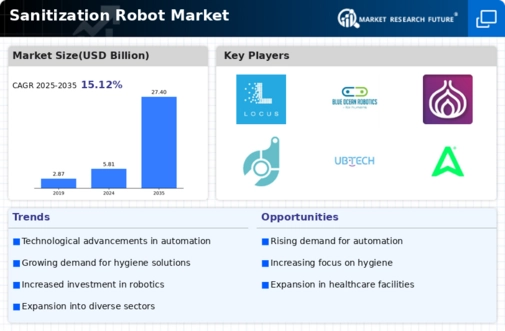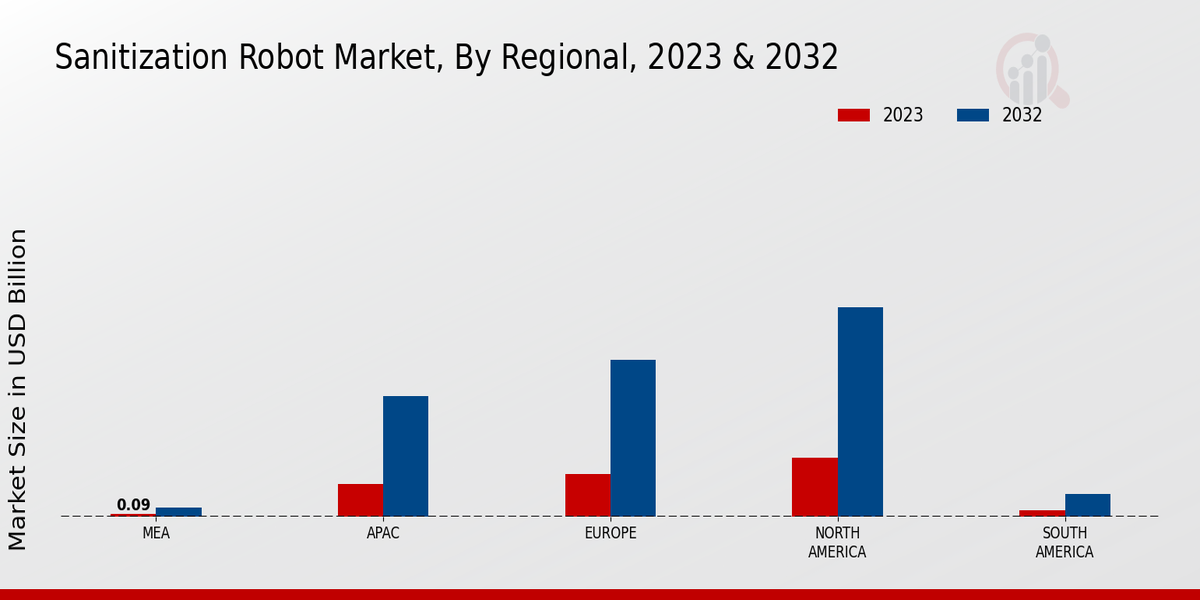Market Growth Projections
The Global Sanitization Robot Market Industry is poised for substantial growth, with projections indicating a market size of 5.81 USD Billion in 2024 and an anticipated increase to 27.4 USD Billion by 2035. This growth trajectory suggests a robust compound annual growth rate (CAGR) of 15.13% from 2025 to 2035. Such figures underscore the increasing reliance on robotic solutions for sanitization across various sectors, including healthcare, hospitality, and public transportation. The market's expansion is likely driven by technological advancements, rising demand for hygiene solutions, and supportive government initiatives, positioning sanitization robots as essential tools in maintaining cleanliness and safety.
Growing Adoption in Healthcare Sector
The healthcare sector's growing adoption of sanitization robots significantly contributes to the expansion of the Global Sanitization Robot Market Industry. Hospitals and clinics are increasingly recognizing the importance of maintaining sterile environments to prevent infections and enhance patient safety. Sanitization robots equipped with advanced disinfection technologies are being integrated into healthcare facilities to ensure thorough cleaning of high-touch surfaces and patient areas. This trend is likely to continue, as healthcare organizations prioritize infection control measures. The increasing investment in robotic sanitization solutions reflects a commitment to improving patient outcomes and operational efficiency in healthcare settings.
Government Initiatives and Regulations
Government initiatives and regulations aimed at promoting public health and safety are crucial drivers of the Global Sanitization Robot Market Industry. Many governments are implementing stringent hygiene standards in public spaces, healthcare facilities, and transportation systems. These regulations often encourage the adoption of advanced sanitization technologies, including robots. For instance, funding programs and grants may be available for organizations that invest in automated sanitization solutions. Such initiatives not only foster innovation but also create a conducive environment for the growth of the market, as compliance with health regulations becomes increasingly important for businesses and institutions.
Technological Advancements in Robotics
Technological advancements play a pivotal role in the growth of the Global Sanitization Robot Market Industry. Innovations in artificial intelligence, machine learning, and sensor technologies enhance the capabilities of sanitization robots, allowing for more effective and autonomous operations. These robots can navigate complex environments, adapt to various surfaces, and optimize disinfectant usage. As a result, the market is expected to expand significantly, with projections indicating a growth to 27.4 USD Billion by 2035. The continuous evolution of robotics technology not only improves the efficiency of sanitization processes but also reduces operational costs, making it an attractive investment for businesses.
Increasing Demand for Hygiene Solutions
The Global Sanitization Robot Market Industry experiences a surge in demand for advanced hygiene solutions across various sectors. This trend is driven by heightened awareness of cleanliness and the necessity for effective sanitization in public spaces, healthcare facilities, and educational institutions. As of 2024, the market is projected to reach 5.81 USD Billion, reflecting a growing recognition of the importance of maintaining sanitized environments. The integration of robotic technology in sanitization processes not only enhances efficiency but also ensures consistent application of disinfectants, thereby reducing human error. This increasing demand indicates a shift towards automation in hygiene practices.
Rising Labor Costs and Workforce Challenges
Rising labor costs and workforce challenges are significant factors influencing the Global Sanitization Robot Market Industry. As businesses face increasing expenses related to hiring and training personnel, many are turning to automation as a viable solution. Sanitization robots offer a cost-effective alternative, capable of performing repetitive tasks with minimal human intervention. This shift towards automation is expected to accelerate market growth, with a projected compound annual growth rate (CAGR) of 15.13% from 2025 to 2035. By reducing reliance on human labor for sanitization tasks, organizations can allocate resources more efficiently and maintain high standards of cleanliness.









